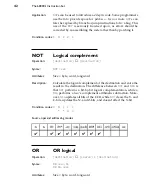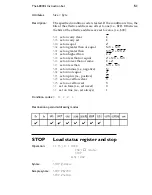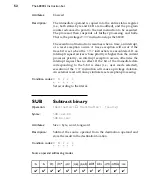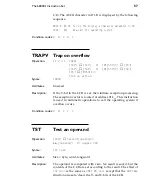
56
The 68000's Instruction Set
high-order bit of the operand (i.e., bit 7) is set. This operation is
indivisible
and uses a read-modify-write cycle. Its principal
application is in multiprocessor systems.
Application:
The
TAS
instruction permits one processor in a multiprocessor
system to test a resource (e.g., shared memory) and claim the
resource if it is free. The most-significant bit of the byte at the
effective address is used as a semaphore to indicate whether the
shared resource is free. The
TAS
instruction reads the semaphore
bit to find the state of the resource, and then sets the semaphore
to claim the resource (if it was free). Because the operation is
indivisible, no other processor can access the memory between
the testing of the bit and its subsequent setting.
Condition codes:
X N Z V C
- * * 0 0
Source operand addressing modes
TRAP
Trap
Operation:
S
←
1;
[SSP]
←
[SSP] - 4; [M([SSP])]
←
[PC];
[SSP]
←
[SSP] - 2; [M([SSP])]
←
[SR];
[PC]
←
vector
Syntax:
TRAP #<vector>
Attributes:
Unsized
Description:
This instruction forces the processor to initiate exception
processing. The vector number used by the
TRAP
instruction is in
the range 0 to 15 and, therefore, supports 16 traps (i.e.,
TRAP
#0
to
TRAP
#15
).
Application:
The
TRAP
instruction is used to perform operating system calls
and is system independent. That is, the effect of the call depends
on the particular operating environment. For example, the
University of Teesside 68000 simulator uses
TRAP
#15
to perform
Summary of Contents for 68000
Page 1: ...Motorola 68000 s Instruction Set ...
Page 2: ......


































